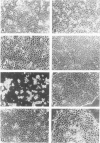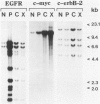Abstract
In our effort to delineate factors that govern the ability of non-small cell lung carcinoma (NSCLC) to form monolayer cell lines, we have attempted to derive monolayer cell lines from the primary cultures of 29 unselected human NSCLCs. Eight new lines were obtained. Cell lines were easier to establish from poorly differentiated tumors, especially adenocarcinomas. One cell line was from a large cell neuroendocrine carcinoma. All cell lines were aneuploid, and they exhibited heterogeneous nutritional requirements for growth in vitro. Cell line-forming primary tumors demonstrated higher mean messenger RNA expression levels for transforming growth factor-alpha and c-met proto-oncogene than did tumors that failed to form cell lines. Although a high level of c-myc expression was correlated with the ability of NSCLC cell lines to form xenograft tumors in nude mice, it was not correlated with the ability of primary tumors to establish cell lines. The results suggest that autocrine growth loops play important roles in the ability of NSCLC cells to proliferate continuously in monolayer culture. The fact that the overexpression of transforming growth factor-alpha in NSCLCs has been negatively correlated with patient survival and that most cell lines can be established only from poorly differentiated carcinomas may provide the explanation for a previous report that the capability for cell line establishment constitutes a negative prognostic indicator for patient survival. However, when the genotype and phenotype of the cell lines were compared with those of their corresponding primary or xenograft tumors, the tumor cells that grew continuously as a cell line often represented a selective subpopulation of the heterogeneous neoplastic cells in the primary tumors. This finding should be taken into consideration when cell lines are used to evaluate the chemo- and radiosensitivity of tumor cells.
Full text
PDF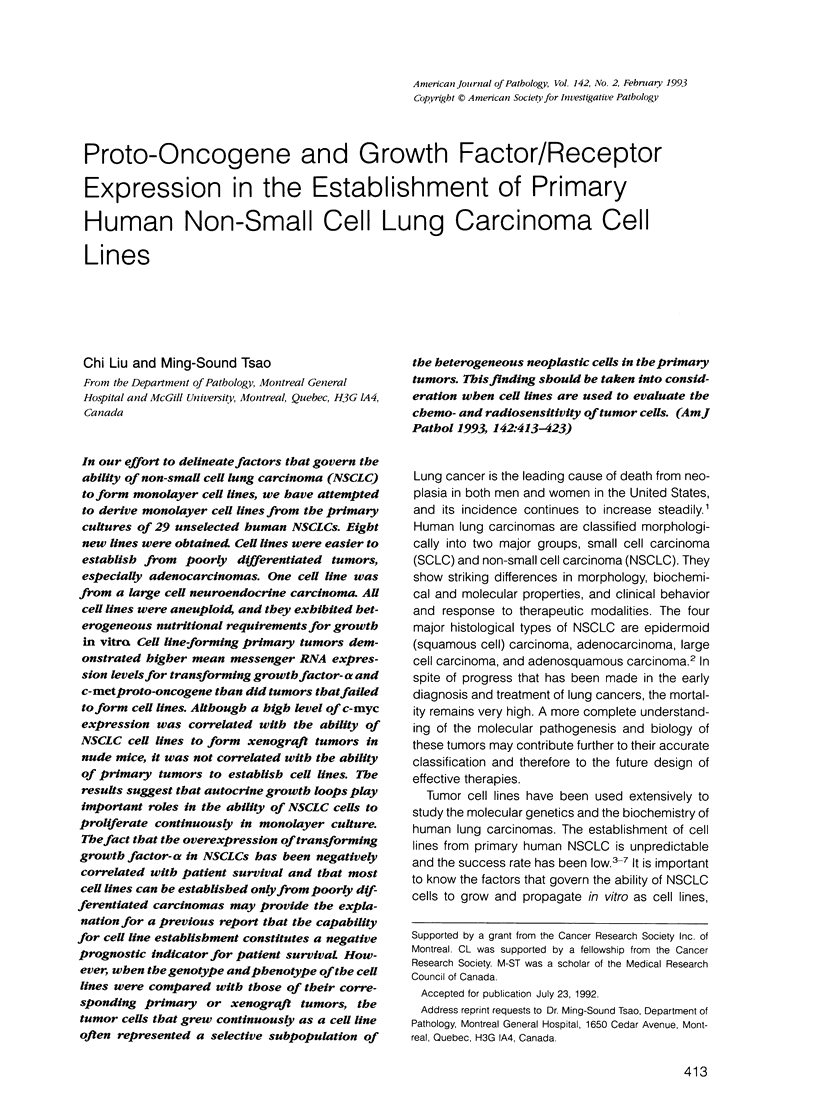
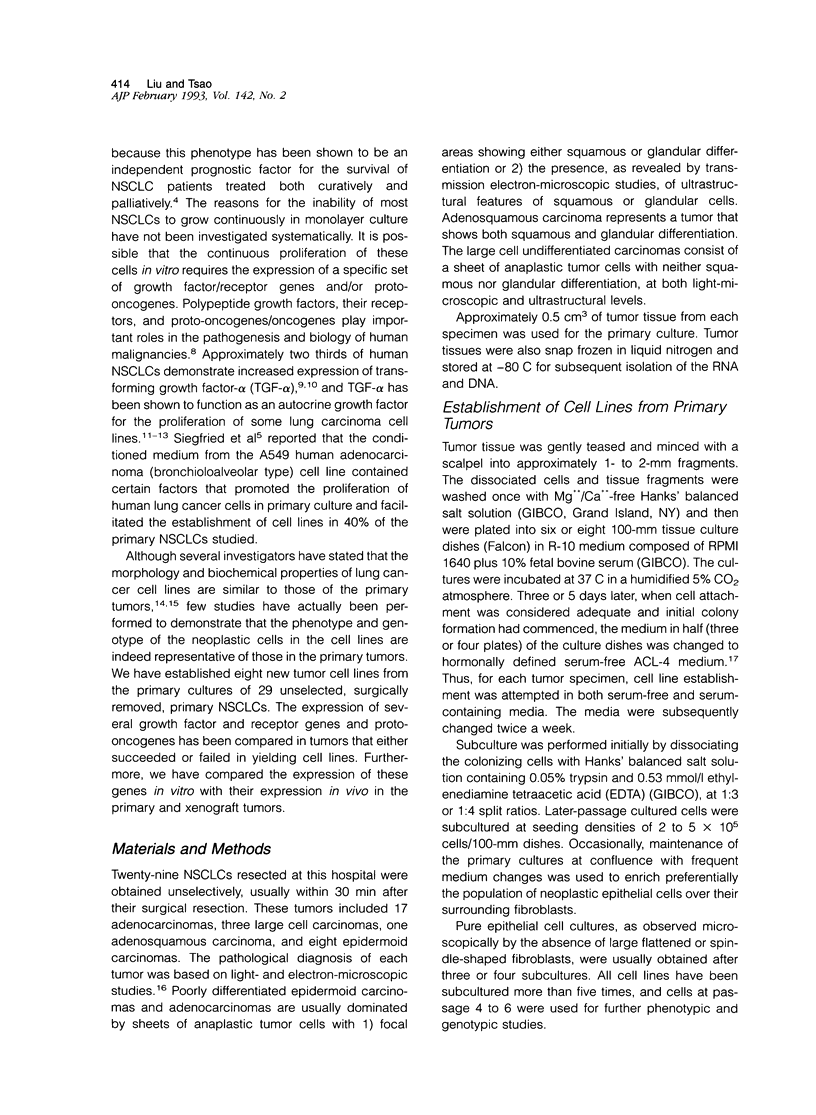
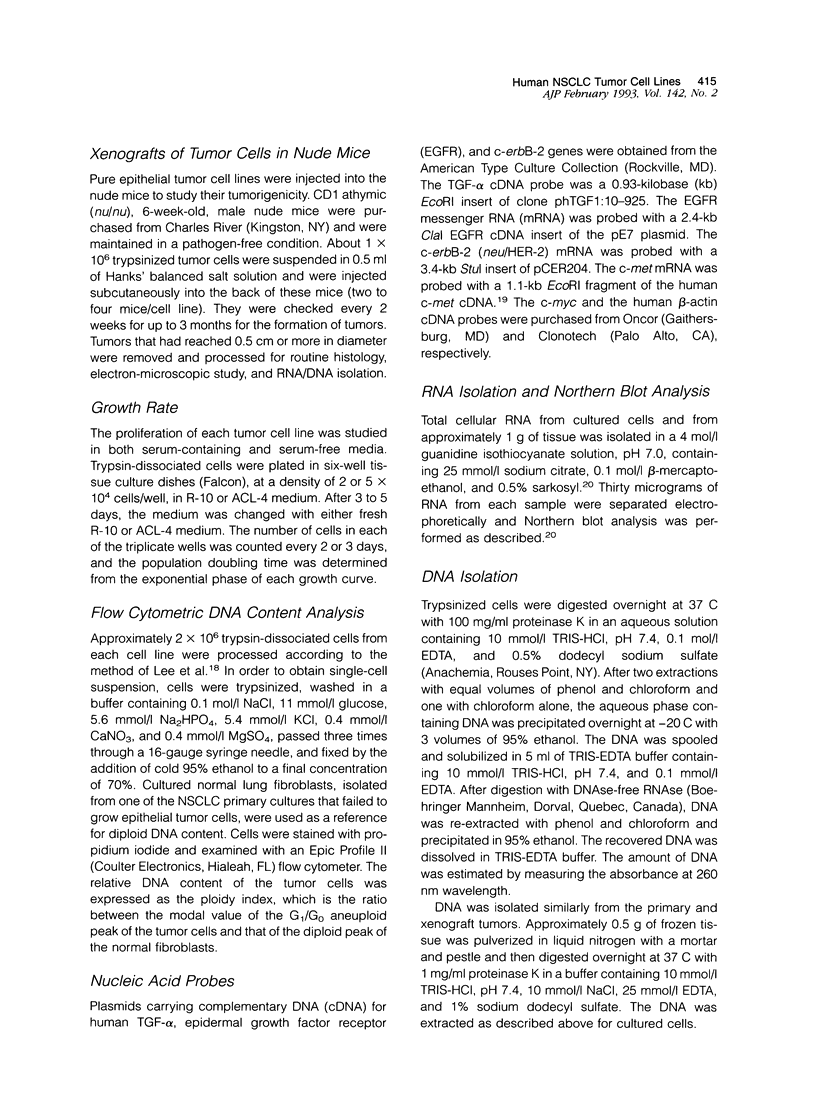
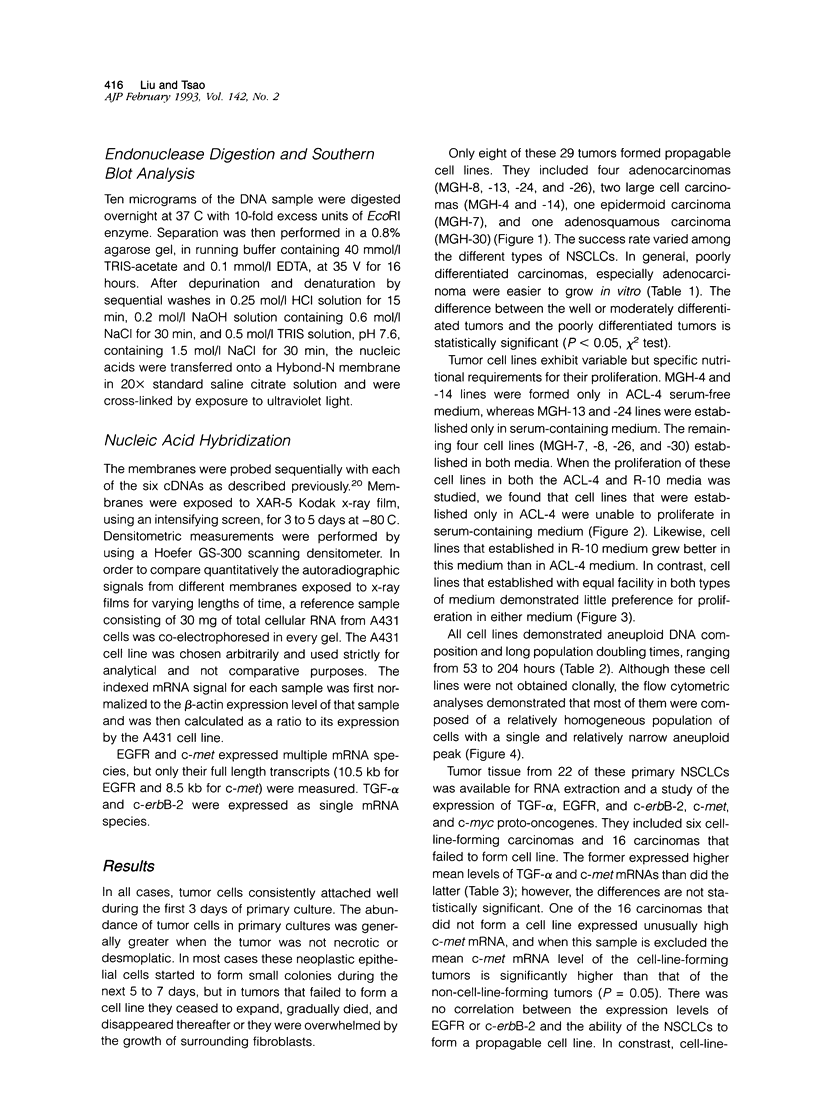
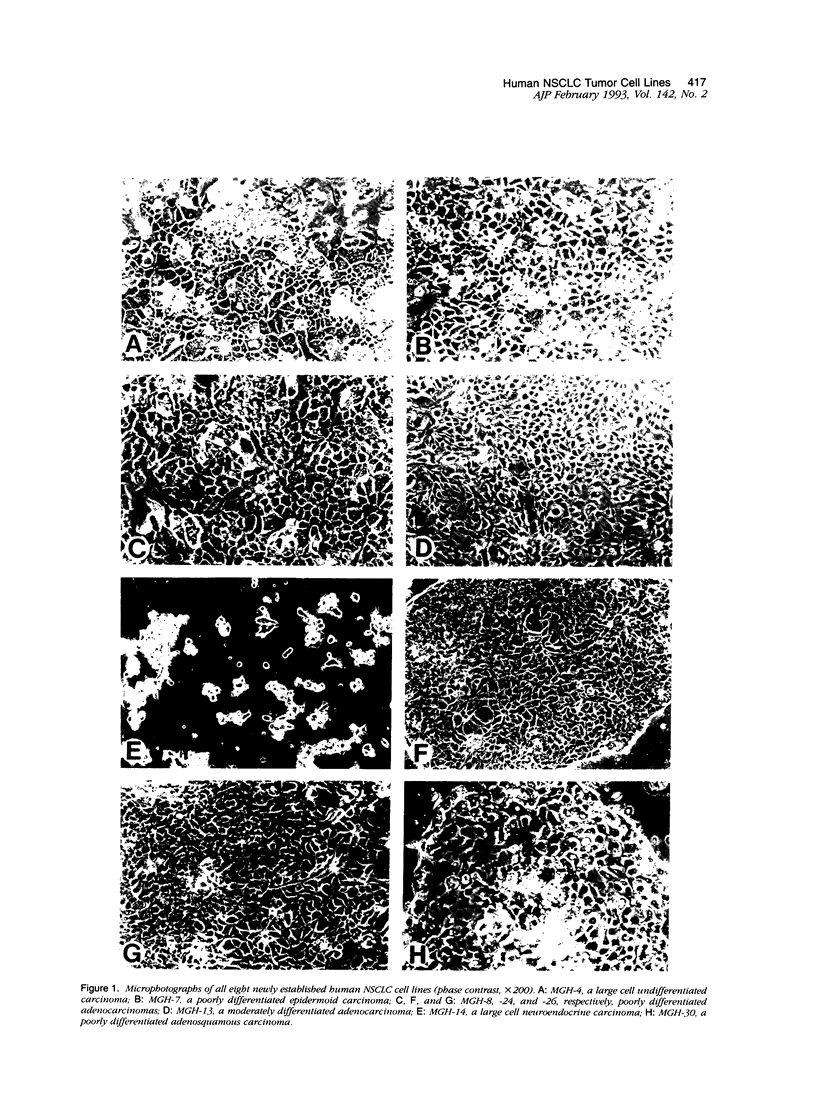
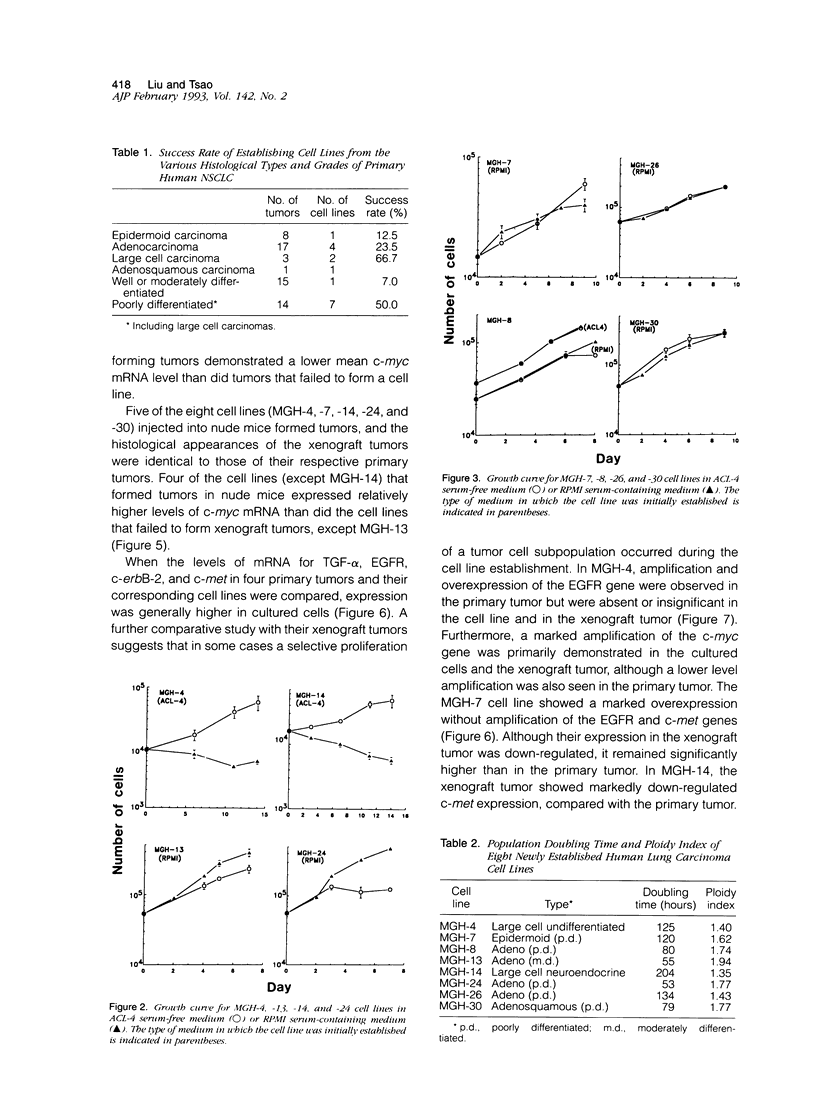
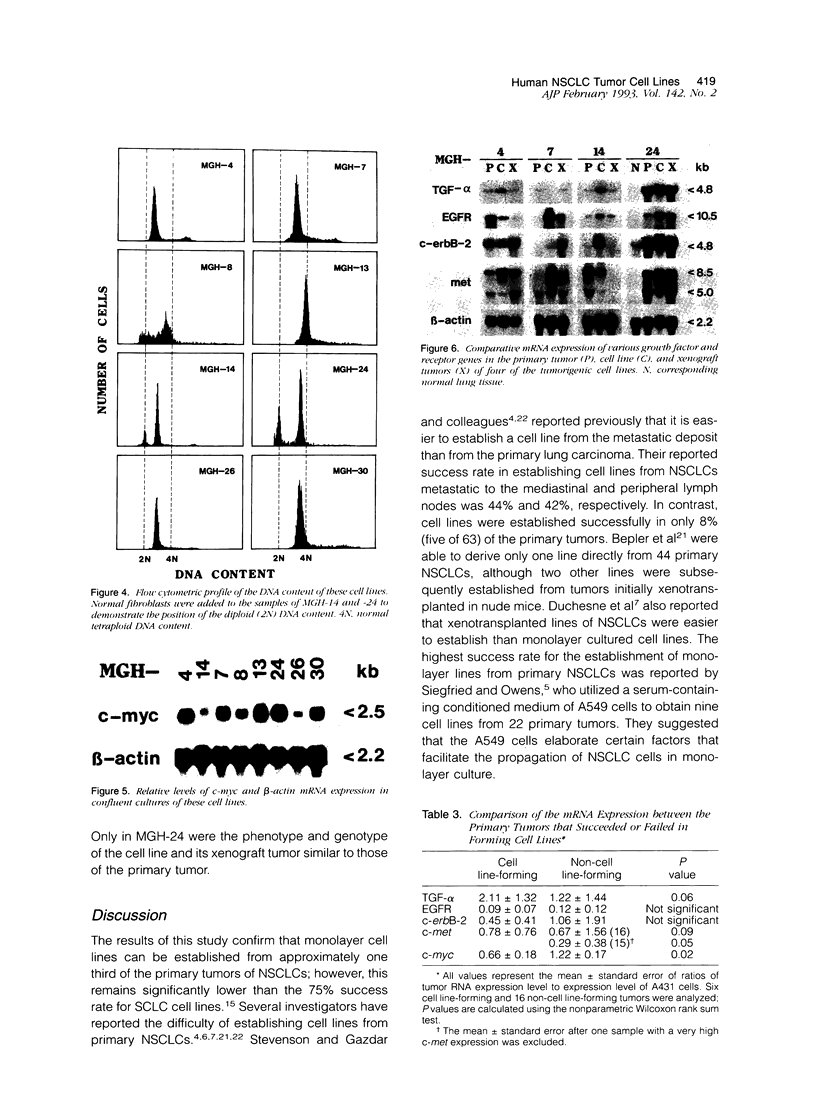
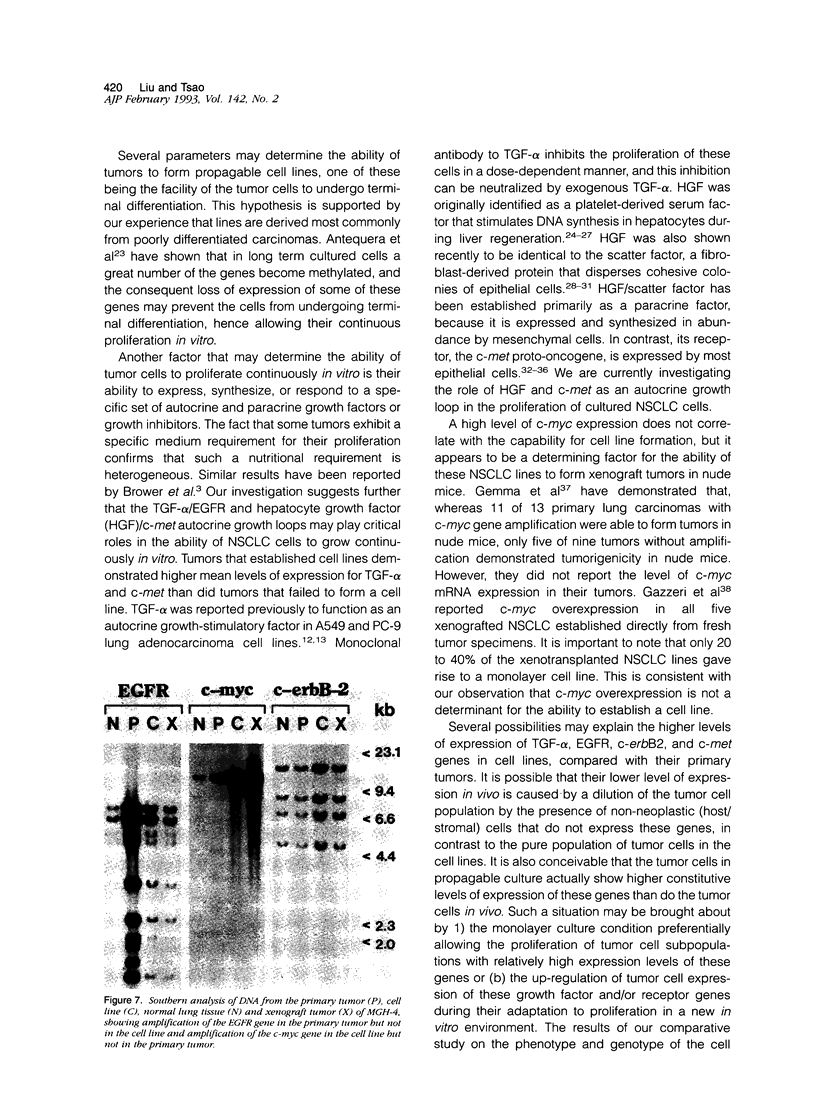
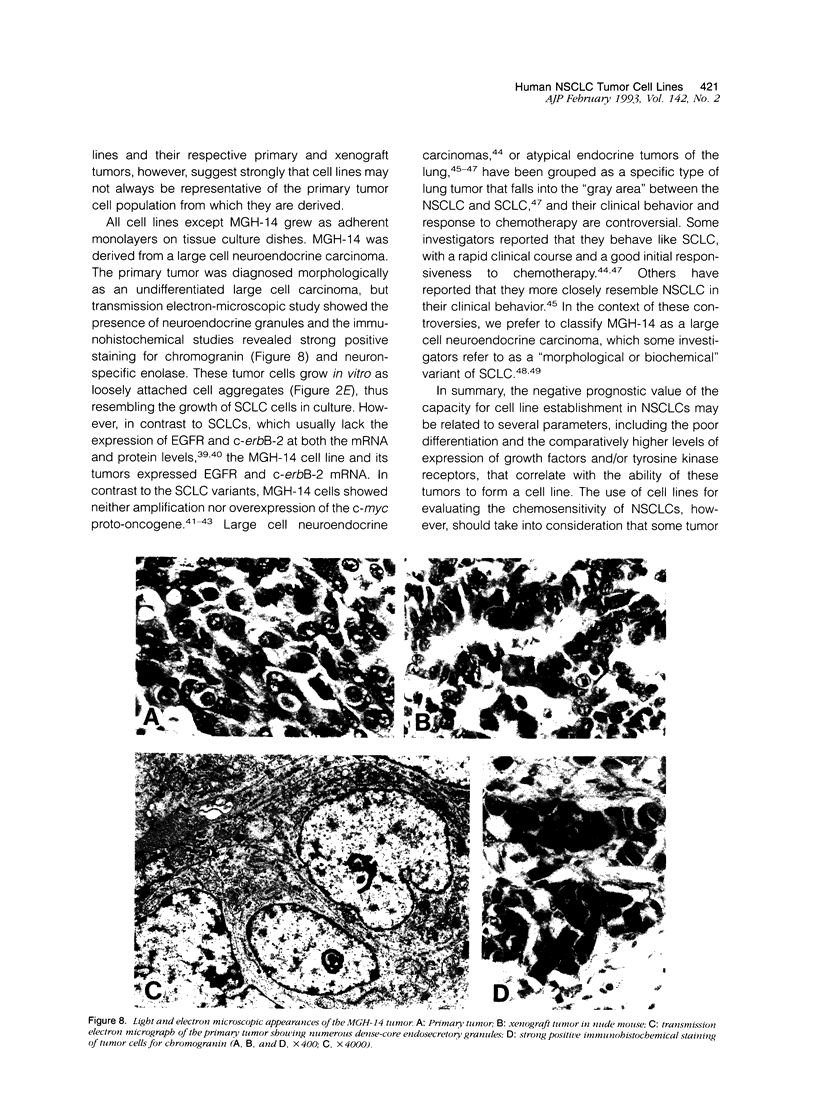
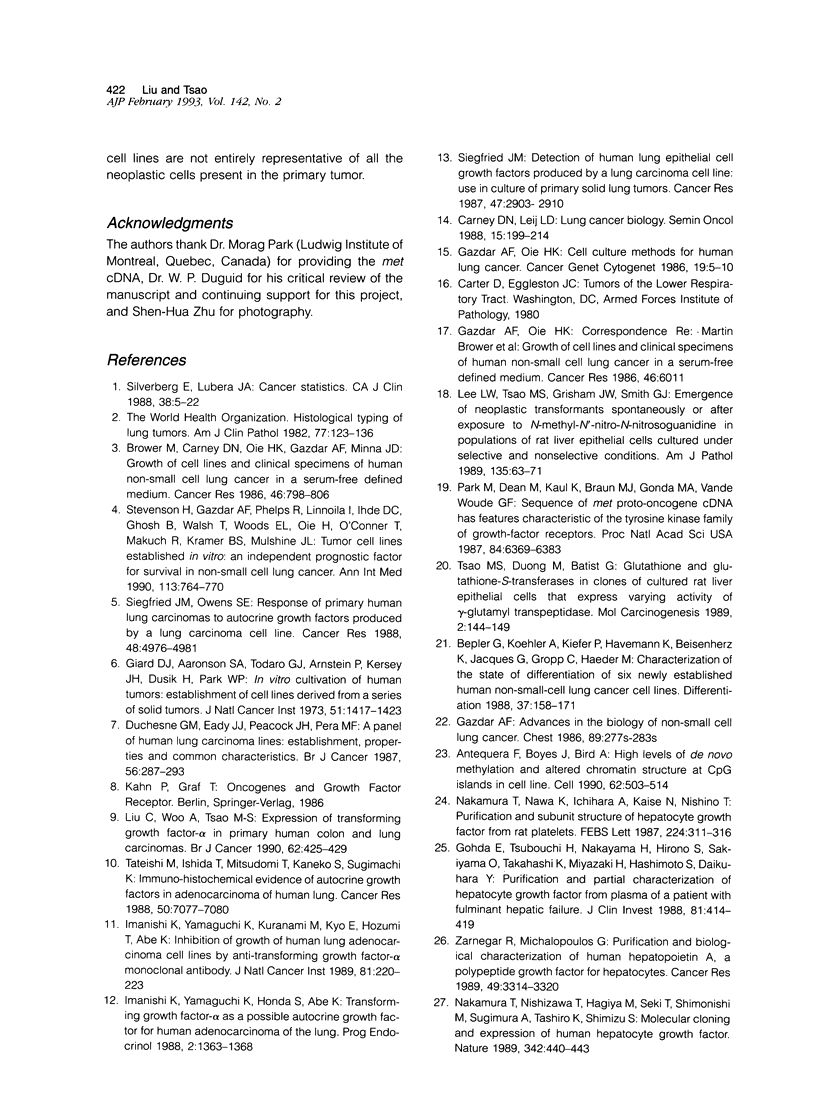
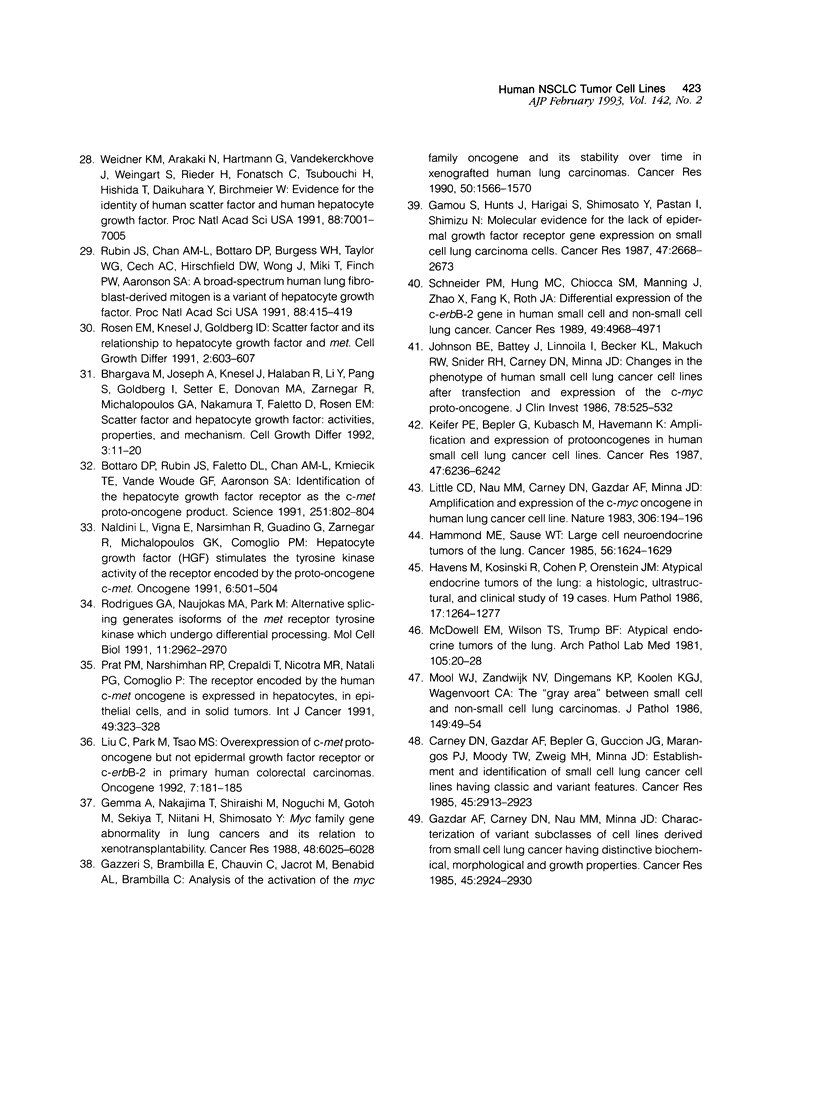
Images in this article
Selected References
These references are in PubMed. This may not be the complete list of references from this article.
- Antequera F., Boyes J., Bird A. High levels of de novo methylation and altered chromatin structure at CpG islands in cell lines. Cell. 1990 Aug 10;62(3):503–514. doi: 10.1016/0092-8674(90)90015-7. [DOI] [PubMed] [Google Scholar]
- Bepler G., Koehler A., Kiefer P., Havemann K., Beisenherz K., Jaques G., Gropp C., Haeder M. Characterization of the state of differentiation of six newly established human non-small-cell lung cancer cell lines. Differentiation. 1988;37(2):158–171. doi: 10.1111/j.1432-0436.1988.tb00806.x. [DOI] [PubMed] [Google Scholar]
- Bhargava M., Joseph A., Knesel J., Halaban R., Li Y., Pang S., Goldberg I., Setter E., Donovan M. A., Zarnegar R. Scatter factor and hepatocyte growth factor: activities, properties, and mechanism. Cell Growth Differ. 1992 Jan;3(1):11–20. [PubMed] [Google Scholar]
- Bottaro D. P., Rubin J. S., Faletto D. L., Chan A. M., Kmiecik T. E., Vande Woude G. F., Aaronson S. A. Identification of the hepatocyte growth factor receptor as the c-met proto-oncogene product. Science. 1991 Feb 15;251(4995):802–804. doi: 10.1126/science.1846706. [DOI] [PubMed] [Google Scholar]
- Brower M., Carney D. N., Oie H. K., Gazdar A. F., Minna J. D. Growth of cell lines and clinical specimens of human non-small cell lung cancer in a serum-free defined medium. Cancer Res. 1986 Feb;46(2):798–806. [PubMed] [Google Scholar]
- Carney D. N., De Leij L. Lung cancer biology. Semin Oncol. 1988 Jun;15(3):199–214. [PubMed] [Google Scholar]
- Carney D. N., Gazdar A. F., Bepler G., Guccion J. G., Marangos P. J., Moody T. W., Zweig M. H., Minna J. D. Establishment and identification of small cell lung cancer cell lines having classic and variant features. Cancer Res. 1985 Jun;45(6):2913–2923. [PubMed] [Google Scholar]
- Duchesne G. M., Eady J. J., Peacock J. H., Pera M. F. A panel of human lung carcinoma lines: establishment, properties and common characteristics. Br J Cancer. 1987 Sep;56(3):287–293. doi: 10.1038/bjc.1987.191. [DOI] [PMC free article] [PubMed] [Google Scholar]
- Gamou S., Hunts J., Harigai H., Hirohashi S., Shimosato Y., Pastan I., Shimizu N. Molecular evidence for the lack of epidermal growth factor receptor gene expression in small cell lung carcinoma cells. Cancer Res. 1987 May 15;47(10):2668–2673. [PubMed] [Google Scholar]
- Gazdar A. F. Advances in the biology of non-small cell lung cancer. Chest. 1986 Apr;89(4 Suppl):277S–283S. doi: 10.1378/chest.89.4.277s. [DOI] [PubMed] [Google Scholar]
- Gazdar A. F., Carney D. N., Nau M. M., Minna J. D. Characterization of variant subclasses of cell lines derived from small cell lung cancer having distinctive biochemical, morphological, and growth properties. Cancer Res. 1985 Jun;45(6):2924–2930. [PubMed] [Google Scholar]
- Gazdar A. F., Oie H. K. Cell culture methods for human lung cancer. Cancer Genet Cytogenet. 1986 Jan 1;19(1-2):5–10. doi: 10.1016/0165-4608(86)90365-1. [DOI] [PubMed] [Google Scholar]
- Gazdar A. F., Oie H. K. Re: Growth of cell lines and clinical specimens of human non-small cell lung cancer in a serum-free defined medium. Cancer Res. 1986 Nov;46(11):6011–6012. [PubMed] [Google Scholar]
- Gazzeri S., Brambilla E., Chauvin C., Jacrot M., Benabid A. L., Brambilla C. Analysis of the activation of the myc family oncogene and of its stability over time in xenografted human lung carcinomas. Cancer Res. 1990 Mar 1;50(5):1566–1570. [PubMed] [Google Scholar]
- Gemma A., Nakajima T., Shiraishi M., Noguchi M., Gotoh M., Sekiya T., Niitani H., Shimosato Y. myc family gene abnormality in lung cancers and its relation to xenotransplantability. Cancer Res. 1988 Nov 1;48(21):6025–6028. [PubMed] [Google Scholar]
- Giard D. J., Aaronson S. A., Todaro G. J., Arnstein P., Kersey J. H., Dosik H., Parks W. P. In vitro cultivation of human tumors: establishment of cell lines derived from a series of solid tumors. J Natl Cancer Inst. 1973 Nov;51(5):1417–1423. doi: 10.1093/jnci/51.5.1417. [DOI] [PubMed] [Google Scholar]
- Gohda E., Tsubouchi H., Nakayama H., Hirono S., Sakiyama O., Takahashi K., Miyazaki H., Hashimoto S., Daikuhara Y. Purification and partial characterization of hepatocyte growth factor from plasma of a patient with fulminant hepatic failure. J Clin Invest. 1988 Feb;81(2):414–419. doi: 10.1172/JCI113334. [DOI] [PMC free article] [PubMed] [Google Scholar]
- Hammond M. E., Sause W. T. Large cell neuroendocrine tumors of the lung. Clinical significance and histopathologic definition. Cancer. 1985 Oct 1;56(7):1624–1629. doi: 10.1002/1097-0142(19851001)56:7<1624::aid-cncr2820560727>3.0.co;2-3. [DOI] [PubMed] [Google Scholar]
- Imanishi K., Yamaguchi K., Kuranami M., Kyo E., Hozumi T., Abe K. Inhibition of growth of human lung adenocarcinoma cell lines by anti-transforming growth factor-alpha monoclonal antibody. J Natl Cancer Inst. 1989 Feb 1;81(3):220–223. doi: 10.1093/jnci/81.3.220. [DOI] [PubMed] [Google Scholar]
- Johnson B. E., Battey J., Linnoila I., Becker K. L., Makuch R. W., Snider R. H., Carney D. N., Minna J. D. Changes in the phenotype of human small cell lung cancer cell lines after transfection and expression of the c-myc proto-oncogene. J Clin Invest. 1986 Aug;78(2):525–532. doi: 10.1172/JCI112604. [DOI] [PMC free article] [PubMed] [Google Scholar]
- Kiefer P. E., Bepler G., Kubasch M., Havemann K. Amplification and expression of protooncogenes in human small cell lung cancer cell lines. Cancer Res. 1987 Dec 1;47(23):6236–6242. [PubMed] [Google Scholar]
- Lee L. W., Tsao M. S., Grisham J. W., Smith G. J. Emergence of neoplastic transformants spontaneously or after exposure to N-methyl-N'-nitro-N-nitrosoguanidine in populations of rat liver epithelial cells cultured under selective and nonselective conditions. Am J Pathol. 1989 Jul;135(1):63–71. [PMC free article] [PubMed] [Google Scholar]
- Little C. D., Nau M. M., Carney D. N., Gazdar A. F., Minna J. D. Amplification and expression of the c-myc oncogene in human lung cancer cell lines. Nature. 1983 Nov 10;306(5939):194–196. doi: 10.1038/306194a0. [DOI] [PubMed] [Google Scholar]
- Liu C., Park M., Tsao M. S. Overexpression of c-met proto-oncogene but not epidermal growth factor receptor or c-erbB-2 in primary human colorectal carcinomas. Oncogene. 1992 Jan;7(1):181–185. [PubMed] [Google Scholar]
- Liu C., Woo A., Tsao M. S. Expression of transforming growth factor-alpha in primary human colon and lung carcinomas. Br J Cancer. 1990 Sep;62(3):425–429. doi: 10.1038/bjc.1990.311. [DOI] [PMC free article] [PubMed] [Google Scholar]
- McDowell E. M., Wilson T. S., Trump B. F. Atypical endocrine tumors of the lung. Arch Pathol Lab Med. 1981 Jan;105(1):20–28. [PubMed] [Google Scholar]
- Mooi W. J., Van Zandwijk N., Dingemans K. P., Koolen M. G., Wagenvoort C. A. The 'grey area' between small cell and non-small cell lung carcinomas. Light and electron microscopy versus clinical data in 14 cases. J Pathol. 1986 May;149(1):49–54. doi: 10.1002/path.1711490110. [DOI] [PubMed] [Google Scholar]
- Nakamura T., Nawa K., Ichihara A., Kaise N., Nishino T. Purification and subunit structure of hepatocyte growth factor from rat platelets. FEBS Lett. 1987 Nov 30;224(2):311–316. doi: 10.1016/0014-5793(87)80475-1. [DOI] [PubMed] [Google Scholar]
- Nakamura T., Nishizawa T., Hagiya M., Seki T., Shimonishi M., Sugimura A., Tashiro K., Shimizu S. Molecular cloning and expression of human hepatocyte growth factor. Nature. 1989 Nov 23;342(6248):440–443. doi: 10.1038/342440a0. [DOI] [PubMed] [Google Scholar]
- Naldini L., Vigna E., Narsimhan R. P., Gaudino G., Zarnegar R., Michalopoulos G. K., Comoglio P. M. Hepatocyte growth factor (HGF) stimulates the tyrosine kinase activity of the receptor encoded by the proto-oncogene c-MET. Oncogene. 1991 Apr;6(4):501–504. [PubMed] [Google Scholar]
- Neal M. H., Kosinski R., Cohen P., Orenstein J. M. Atypical endocrine tumors of the lung: a histologic, ultrastructural, and clinical study of 19 cases. Hum Pathol. 1986 Dec;17(12):1264–1277. doi: 10.1016/s0046-8177(86)80571-8. [DOI] [PubMed] [Google Scholar]
- Park M., Dean M., Kaul K., Braun M. J., Gonda M. A., Vande Woude G. Sequence of MET protooncogene cDNA has features characteristic of the tyrosine kinase family of growth-factor receptors. Proc Natl Acad Sci U S A. 1987 Sep;84(18):6379–6383. doi: 10.1073/pnas.84.18.6379. [DOI] [PMC free article] [PubMed] [Google Scholar]
- Prat M., Narsimhan R. P., Crepaldi T., Nicotra M. R., Natali P. G., Comoglio P. M. The receptor encoded by the human c-MET oncogene is expressed in hepatocytes, epithelial cells and solid tumors. Int J Cancer. 1991 Sep 30;49(3):323–328. doi: 10.1002/ijc.2910490302. [DOI] [PubMed] [Google Scholar]
- Rodrigues G. A., Naujokas M. A., Park M. Alternative splicing generates isoforms of the met receptor tyrosine kinase which undergo differential processing. Mol Cell Biol. 1991 Jun;11(6):2962–2970. doi: 10.1128/mcb.11.6.2962. [DOI] [PMC free article] [PubMed] [Google Scholar]
- Rosen E. M., Knesel J., Goldberg I. D. Scatter factor and its relationship to hepatocyte growth factor and met. Cell Growth Differ. 1991 Nov;2(11):603–607. [PubMed] [Google Scholar]
- Rubin J. S., Chan A. M., Bottaro D. P., Burgess W. H., Taylor W. G., Cech A. C., Hirschfield D. W., Wong J., Miki T., Finch P. W. A broad-spectrum human lung fibroblast-derived mitogen is a variant of hepatocyte growth factor. Proc Natl Acad Sci U S A. 1991 Jan 15;88(2):415–419. doi: 10.1073/pnas.88.2.415. [DOI] [PMC free article] [PubMed] [Google Scholar]
- Schneider P. M., Hung M. C., Chiocca S. M., Manning J., Zhao X. Y., Fang K., Roth J. A. Differential expression of the c-erbB-2 gene in human small cell and non-small cell lung cancer. Cancer Res. 1989 Sep 15;49(18):4968–4971. [PubMed] [Google Scholar]
- Siegfried J. M. Detection of human lung epithelial cell growth factors produced by a lung carcinoma cell line: use in culture of primary solid lung tumors. Cancer Res. 1987 Jun 1;47(11):2903–2910. [PubMed] [Google Scholar]
- Siegfried J. M., Owens S. E. Response of primary human lung carcinomas to autocrine growth factors produced by a lung carcinoma cell line. Cancer Res. 1988 Sep 1;48(17):4976–4981. [PubMed] [Google Scholar]
- Silverberg E., Lubera J. A. Cancer statistics, 1988. CA Cancer J Clin. 1988 Jan-Feb;38(1):5–22. doi: 10.3322/canjclin.38.1.5. [DOI] [PubMed] [Google Scholar]
- Stevenson H., Gazdar A. F., Phelps R., Linnoila R. I., Ihde D. C., Ghosh B., Walsh T., Woods E. L., Oie H., O'Connor T. Tumor cell lines established in vitro: an independent prognostic factor for survival in non-small-cell lung cancer. Ann Intern Med. 1990 Nov 15;113(10):764–770. doi: 10.7326/0003-4819-113-10-764. [DOI] [PubMed] [Google Scholar]
- Tateishi M., Ishida T., Mitsudomi T., Kaneko S., Sugimachi K. Immunohistochemical evidence of autocrine growth factors in adenocarcinoma of the human lung. Cancer Res. 1990 Nov 1;50(21):7077–7080. [PubMed] [Google Scholar]
- Tsao M. S., Duong M., Batist G. Glutathione and glutathione S-transferases in clones of cultured rat liver epithelial cells that express varying activity of gamma-glutamyl transpeptidase. Mol Carcinog. 1989;2(3):144–149. doi: 10.1002/mc.2940020307. [DOI] [PubMed] [Google Scholar]
- Weidner K. M., Arakaki N., Hartmann G., Vandekerckhove J., Weingart S., Rieder H., Fonatsch C., Tsubouchi H., Hishida T., Daikuhara Y. Evidence for the identity of human scatter factor and human hepatocyte growth factor. Proc Natl Acad Sci U S A. 1991 Aug 15;88(16):7001–7005. doi: 10.1073/pnas.88.16.7001. [DOI] [PMC free article] [PubMed] [Google Scholar]
- Zarnegar R., Michalopoulos G. Purification and biological characterization of human hepatopoietin A, a polypeptide growth factor for hepatocytes. Cancer Res. 1989 Jun 15;49(12):3314–3320. [PubMed] [Google Scholar]



